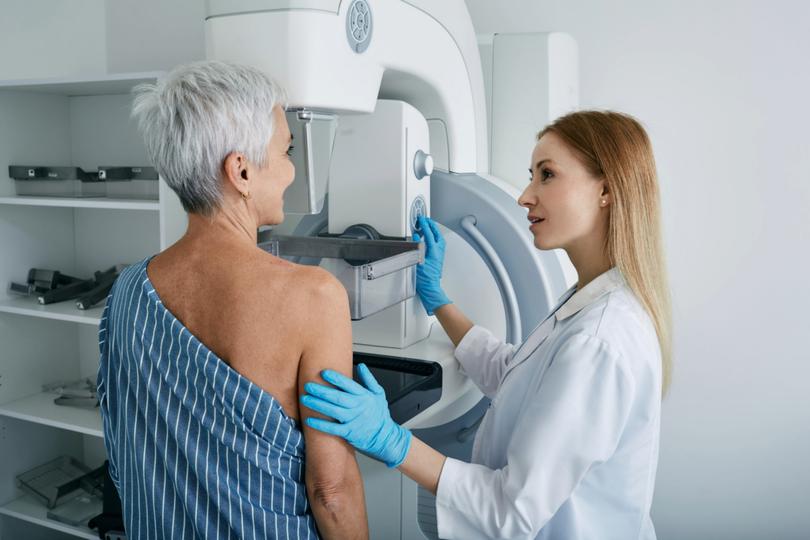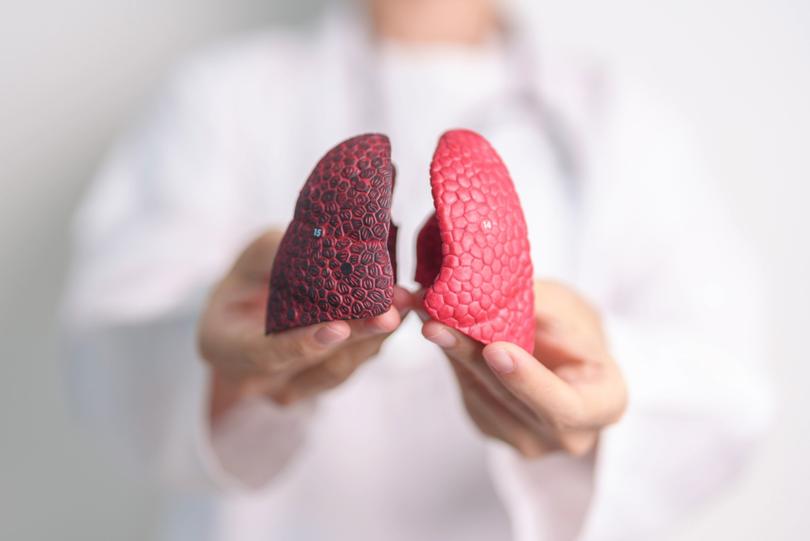Which side of your body is more likely to get cancer, blood clots, arthritis and other diseases

When it comes to health conditions, your body often takes sides. In fact, there are many illnesses that predominantly affect one side of the body — and that’s not simply because we favour one side, though tennis elbow, for instance, is more common on the right side because more people are right-handed.
“At first glance, it looks as though human beings are symmetrical, with two arms, two eyes, two legs and twin organs such as the kidneys and lungs,” says Gareth Nye, a senior lecturer in anatomy and physiology at the University of Chester.
“But in fact, our physiology is not the same on both sides, which causes a range of consequences when it comes to our health.
Sign up to The Nightly's newsletters.
Get the first look at the digital newspaper, curated daily stories and breaking headlines delivered to your inbox.
By continuing you agree to our Terms and Privacy Policy.“For example, the two sides of the brain may look similar, but they control different functions in the body. This means that if you have damage to one side as a result of a stroke or an accident, for instance, the effects may be completely different from damage to the other side.”
That means a stroke on the left side of the brain might result in problems with speech, eyesight and understanding language, while a stroke on the right side could result in mood changes, a shorter attention span and numbness or paralysis on the left side of the body.
Even organs that exist in pairs, such as the kidneys and the lungs, are not symmetrical: the right lung is larger than the left, for instance.
Meanwhile, single organs, such as the liver, spleen or appendix, are set to one side. Even the heart leans more to the left side of the body.
“The implication of all of these anatomical quirks is that when problems occur, they can be one-sided and affect one half of the body more than the other,” Nye explains.
Here, we look at some common conditions that tend to occur on just one side of the body, and what that means for their diagnosis and treatment.
MORE COMMON ON THE LEFT SIDE
STROKE
Each year in the UK, around 100,000 people suffer ischaemic strokes, where blood supply to the brain is cut off. According to the National Institutes of Health in the US, left-sided strokes are the most common.
“Previous studies have found that left-sided strokes are more common, possibly due to differences in the way blood flows in each of the carotid arteries — the main arteries, one on either side of the neck, that carry blood to the brain,” explains Professor Fayyaz Ahmed, a consultant neurologist at Hull University Teaching Hospitals NHS Trust.
“Blood flows more quickly through the left carotid artery, which runs directly from the aorta [the heart’s biggest artery], without branching off elsewhere.
“This results in higher stress on the artery walls, with potential damage that can lead to clots forming and blocking blood supply to the brain, causing a stroke.”
The fact that the left carotid artery is a branch of the heart’s main artery makes it more likely that any clots around the heart that break off would travel to the left side of the brain and block blood flow there, causing a stroke.
But it may also be that left-sided strokes are more common because they’re more easily recognised than right-sided strokes.
In a 2015 study in the Netherlands, researchers investigated 1,200 strokes and reported that almost 60 per cent of them were left-sided, as confirmed by their medical records and a neurologist — a percentage which is statistically significant.
However, when the researchers then looked at patients’ MRI scans, they found no difference in the distribution of areas of tissue death caused by the lack of blood supply after a stroke, reported the journal Stroke.
They concluded that left-sided strokes were more easily recognised and diagnosed by physicians, although the level of tissue damage was the same for both.
“Left-sided strokes tend to have more obvious symptoms, including loss of speech, whereas right-sided strokes may cause less obvious signs such as loss of spatial awareness, confusion and stumbling,” explains Professor Ahmed.

BREAST CANCER
Breast cancer is slightly more common on the left side, where it is also typically more aggressive and harder to treat, suggests a 2022 study published in Nature.
The US research was based on data from 881,000 breast cancer patients and revealed that just over half of breast cancers occurred on the left side.
In particular, certain types of cancer — poorly differentiated and undifferentiated cancers (where the cells look much less like normal cells and tend to grow more quickly than other types), triple-negative cancers and HER2 positive tumours — which are harder to treat were significantly more prominent on the left side compared with the right.
And a higher number of grade 2 and 3 tumours, which grow faster and have spread beyond the breast, was seen on the left side compared with the right.
When it came to survival outcomes, left-sided tumours were worse, regardless of what type of cancer they were, or how far they had spread.
The researchers said left-sided breast tumours have lower responses to chemotherapy and slightly worse long-term outcomes compared to right-sided breast cancer.
Researchers say the findings are “quite novel” and if validated could “enhance... management approaches in the future”.
Professor Kefah Mokbel, an oncoplastic breast surgeon at the London Breast Institute, says: “There are lots of reasons why left-sided breast cancer could be slightly more common.”
For example, most breasts are not perfectly symmetrical, and usually, the left breast is slightly larger than the right.
If you have more tissue in one breast, there is more glandular tissue and hormonal influence which may develop tumours,” says Professor Mokbel.
“But there could also be other biological or physiological explanations for why left-sided breast cancer was linked to less favourable outcomes.”
One theory is it may be due to incomplete breastfeeding on the left breast. Women are predominantly right-handed and so prefer to breastfeed on the right because it is easier to hold the baby. This could mean that the left breast is not completely emptied of milk, undermining the protective factor of breastfeeding and making it susceptible to tumours, Professor Mokbel told Good Health.
DEEP VEIN THROMBOSIS
Our circulatory systems are not symmetrical because they are governed by the heart, which is off-centre on the left-hand side of the body and has asymmetrical branches to carry blood to organs This means that life-threatening conditions such as deep vein thrombosis (DVT) have a bias to one side of the body: the left.
DVT, which occurs when a clot forms in a vein deep in the leg, usually the calf, occurs as much as 60 per cent more often in the lower left leg compared to the lower right leg.
“As blood moves away from the heart, it circulates around the left side first and the pressure reduces particularly in the lower limbs,” says Gareth Nye.
“This is because the blood isn’t being propelled as powerfully the further it is from the pumping of the heart.
“‘This slowing of the blood and the lower pressure increases the risk for a DVT to form, as blood is more likely to pool. As the left leg is the first place this occurs, it is therefore more likely that clots form on the left side,” he explains.
“There are also anatomical variations with the blood vessels in the left leg, due to the need for them to cross over the trunk, which greatly increase the chance of a DVT.”
Deep vein thrombosis affects around 60,000 people in the UK each year, causing pain, swelling and redness.
“It is a medical emergency because if the clot dislodges it can travel to the lung, causing a potentially fatal pulmonary embolism,” explains Steve Watson, a professor in cardiovascular sciences and cellular pharmacology at the University of Birmingham.
“If you have pain, swelling and tenderness in your leg and you develop breathlessness and chest pain, seek immediate medical attention,” he warns.
COLON CANCER
When it comes to colon cancer, which affects around 268,000 people in the UK, it really does matter whether your cancer is on the right or the left side.
Some researchers even suggest that cancers located in the right or left side of the colon are so different they can be regarded as distinct diseases.
“Left-sided colon cancer, which occurs further down the intestine and the rectum, in an area called the descending colon and the sigmoid colon, occurs more frequently than right-sided colon cancer, but it is generally easier to detect and treat,” says Iain Jourdan, a colorectal consultant surgeon based at the Royal Surrey County Hospital.
“Right-sided tumours are often more challenging to detect during a colonoscopy because they can be flat and harder to see.
“This means patients with right-sided colon cancer are more likely to have advanced cancer — stage 3 or 4 — when it is detected. Right-sided cancer may also show symptoms later.
“This is because the contents of the bowel are more liquid on the right side, because they have not yet had their moisture content removed,” he explains.
Bowel contents gradually lose their water content and become more solid as they move through the large intestine. This means it is less likely that an obstruction will occur in right-side cancer until the tumours are much bigger — “and it’s the obstruction that causes symptoms, such as pain and bloating, which trigger people to seek medical attention,” says Mr Jourdan.
And left-side tumours may have a better prognosis than right-side tumours.
According to the American Cancer Society, genetic mutations can be different depending on whether it started on the right or left side of the colon.
“These differences can affect how the cancer responds to certain treatments, as well as a person’s prognosis,” adds Mr Jourdan.
“Studies suggest that colon cancer on the left side responds better to chemotherapy and targeted therapies such as immunotherapy than right-sided colon cancer,” says Mr Jourdan.
Significantly, polyps — abnormal growths on the bowel lining which can turn cancerous — also tend to behave differently depending on where they arise, adds Mr Jourdan.
“Left-sided polyps often grow slowly and may change into cancerous tumours over several years,” he says.
“Right-sided polyps, on the other hand, are more likely to develop rapidly into cancers and have a higher risk for spreading.”
DIVERTICULITIS
As we age, the colon can start to form bulging pouches in its muscular wall. This can be exacerbated by a lack of dietary fibre and constipation.
While for most people this causes no symptoms, for a minority infection can set in, leading to inflammation, pain and bloating.
“These pockets can then trap stools, which can lead to inflammation known as diverticulitis,” explains Mr Jourdan.
“It can go on to become a diverticular abscess, which is a pus-filled lump, or in rare cases lead to a perforation of the bowel — where it splits and bowel contents can spread into the abdomen, leading to severe infection. This is a surgical emergency.”
The majority of cases affect the sigmoid colon, which is on the left side of the body.
“That’s because this is where gas starts to build up, and bowel contents are harder and drier, which puts pressure on the bowel wall, eventually causing pockets to form. Right-sided diverticulitis is much rarer.
“Symptoms of diverticular disease include bloating, constipation or diarrhoea, blood in your stools and pain in the lower left side of your tummy [right side for right-sided diverticular disease],” says Mr Jourdan.
Mild diverticulitis is usually treated with changes in your diet to include more fibre, and possibly antibiotics.
“In most cases, whether it starts on the right or left side, it clears up completely,” says Mr Jourdan.
“In some cases, surgery to remove the diseased part of the bowel may be necessary.”
MORE COMMON ON THE RIGHT SIDE

LUNG INFECTIONS
As Sir Peter Barnes, a professor of thoracic medicine at the National Heart and Lung Institute, explains: “The right lung is bigger overall and has three lobes [balloon-like sections filled with spongy tissue], not two, like the left.
“This means there is more volume to potentially become infected if someone inhales viruses or pathogens.”
The entry into the right lung is also more vertical through the windpipe, which makes it easier for foreign agents or food debris to get in.
Add to this, the main bronchus — the tube that connects your lungs to your windpipe — is wider and shorter on the right side than on the left, which makes it easier for infective agents such as viruses of aspirated food particles (when something accidentally goes down the ‘wrong way’) to enter that lung.
Indeed, pneumonia caused by food or even saliva getting into the lungs (accounting for up to 30 per cent of people hospitalised with pneumonia, many of them elderly) most commonly occurs in the right lung, reported the journal Quimioterapia, the journal of the Spanish Society of Chemotherapy.
While cancer occurs equally in the right and left lungs, several studies have found that right-sided lung cancer tends to have a worse mortality rate.
This could be because the right lung, which is bigger, makes a greater contribution to overall lung function, so surgery on that side could have more serious complications.
The best way to protect both lungs is to avoid smoking, as this introduces dangerous agents and partially paralysed structures called villi, which help to sweep harmful debris out of the lungs.
HIP ARTHRITIS
THousands of Britons undergo hip replacement surgery every year, usually because of significant pain, inflammation and damage to the hip joint due to conditions such as osteoarthritis (where wear-and-tear-damage due to age causes bone to rub on bone).
Analysis of data collected by the Register of the Orthopaedic Prosthetic Implantology in Italy found a higher rate of hip replacements on the right side (58 per cent), reported the journal Artificial ORgans in 2008, regardless of whether someone was left or right-footed.
The researchers also found that most of the left-footed patients, who used the left foot to lead in power tasks like walking and jumping, were actually right-handed.
The theory is that this may be subjecting their right hip to greater stress because of the disparity between their right-handedness and left-footedness, although the precise mechanism is unclear.
TENNIS ELBOW
Lateral epicondylitis, or tennis elbow, is triggered by overuse of the muscles and tendons of the forearm, near the elbow joint.
According to the NHS, as many as one in three people has the painful condition at some point, although it is more common in the over-40s.
It also tends to affect more people on the right side, simply because more people are right-handed.
As many as 90 per cent of adults in the UK prefer to use their right hand and are right-side dominant.
“Right-handedness is caused by the left side of the brain being dominant,” says Gareth Nye, ‘and it impacts the musculoskeletal system on the right and causes more wear and tear.
“This means that conditions such as carpal tunnel syndrome and tennis elbow tend to occur more frequently on the right side.”
